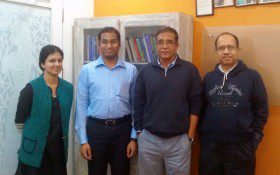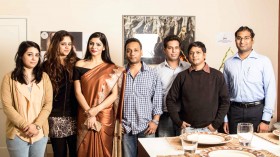SAI’s Livelihood Creation project is underway on the ground in India. The research project, supported by the Tata Trusts, aims to build knowledge and capacity around three key areas: rural livelihood creation (emphasis on the handicrafts and handloom sectors); educational, social and economic empowerment of women; and science and technology-based interventions for poverty alleviation.
By Kundan Madireddy, Project Manager and Dr. Shashank Shah, Project Director
Delhi has been India’s capital for several centuries. The British built New Delhi as the capital of India and Old Delhi served as a capital during the rule of the Mughal Dynasty. With the largest population among Indian metros, Delhi houses about 25 million people and is bordered by the state of Haryana on three sides (North, West and South) and Uttar Pradesh on the East. Delhi has been witness to various invasions and struggles for nearly a dozen centuries, right up to the independence struggle from the British colonizers. It is said that Delhi was built and broken down nine times by various invaders. New Delhi is the tenth version of Delhi in about 1,200 years.
Scripturally, the city is considered to be the capital of the Pandavas in the famous Indian epic, Mahabharata, where it is referred to as Indraprastha. Delhi is also a famous tourist attraction due to its many heritage structures and monuments which include the Red Fort (Lal Qila), Old Fort (Purana Qila), Qutub Minar, Iron Pillar, Jama Masjid, Lotus Temple amongst many others. The Swaminarayan Akshardham built on the banks of Yamuna as recently as 2005 was acknowledged as the world’s largest Hindu temple. So Delhi is a historians’ and architecture lovers’ paradise!
Handicrafts are quite popular in Delhi. Crafts from all states find a place here due to a lot of demand from locals and tourists coming from across India and the globe. Even historically, arts and crafts found significant patronage from different rulers and dynasties that ruled Delhi. Each of these flourished and have been bequeathed generation to generation. As part of its field visits to study crafts organizations across India, the Harvard SAI team visited four organizations in Delhi.
Access Development Services
Access Development Services is a not-for-profit livelihoods promotion organization which helps incubate new institutions and offers technical and managerial assistance in the microfinance and livelihoods space. The handicrafts activities of Access happen under the ‘Ode to Earth’ brand, which acts as a marketing company for the goods made by artisans under the Access umbrella, and also from independent artisans and artisan groups. The artisans are also given a lot of capacity building inputs related to design, finance, and process improvement. Access aims to position ‘Ode to Earth’ as a strong brand with excellent quality, good packaging and labelling, thereby making it a high-value and low-volume game. The SAI team picked up some exquisite jewellery pieces from the ‘Jade’ collection of ‘Ode to Earth’ after the interview.
Earthy Goods Foundation
The mission of the Earthy Goods Foundation is to ensure that small producers do not get excluded from mainstream markets because of their inability to afford professional inputs. And true to its mission, our conversations were around how the Foundation does a lot of mentoring and hand-holding of micro-entrepreneurs in the crafts sector to build artisans’ abilities to make good products and sell them in the market. Reshma Anand, Founder of Earthy Goods Foundation, earlier worked with top companies like Hindustan Unilever and ICICI Bank. She explained how mentoring has to be a sustained and long-term exercise if an artisan or micro-entrepreneur has to become self-confident and self-sufficient to run his/her business. Strategic CSR is another initiative of the Foundation, which helps corporates engage in the crafts sector.
Happy Hands Foundation
Happy Hands is a total serviced-based crafts organization that doesn’t sell any products directly in the market. Its focus is on revival of traditional art forms by not only supporting the artisans through capacity and promoting their products, but also using story-telling and puppetry to promote and revive the crafts. Happy Hands also runs short-term programs like the ‘Rural Fellowship’ and ‘Storytellers Collective’ that encourage youth and the community to get involved in crafts and help artisans through capacity building. A notable innovation that the Foundation is working on is the ‘Travelling Museum’. The museum consists of live ‘light and sound’ shows with artists in costumes explaining their stories and portraying their rich and cultural heritage.
Craftisan
Craftisan is an online handicrafts and handlooms destination that has a huge collection of products. The SAI team visited the Craftisan Office in New Delhi and was surprised to see that there was an in-house studio dedicated to photography. Various products are photographed here and the photos are displayed on the website for customers to see and purchase. Craftisan is an online enterprise that sources crafts products from over 100 NGOs and over 300 artisans and master artisans from 11 states of India. It also does development interventions by assisting artisans in business development, skill training and design improvement. Mahesh Subramaniam, Founder of Craftisan joined us during our conversation on Skype from the United States. He explained how Craftisan believes in giving artisans due credit and recognition they deserve. The organization also participates in policy discussion. It is a part of the Confederation of Indian Industry (CII) Working Group for the handicrafts and handlooms sectors.
Concluding the Field Visits
With this visit, we ended our 10 state-wide and 3 month-long field visit schedule that lasted from October through December 2016. The states our team visited included Rajasthan, Gujarat, Maharashtra, Karnataka, Tamil Nadu, Telangana, Odisha, West Bengal, Uttar Pradesh, and the Delhi National Capital Region. The visits were primarily in the metros and capital cities as our team was interested in studying the work of NGOs and social enterprises that are using their skills and knowledge of management and entrepreneurship to empower the rural artisans, both economically and socially. The objective of these field visits was to study the challenges and issues faced by these organizations in creating greater impact in the lives of the artisans, and to understand the different models of execution adopted by them to achieve this objective. During our interactions, we also found out about the kind of capacity building opportunities that they had received, and the areas where they felt their team needed more of it.
This ground level understanding of challenges, issues, models and gaps in capacity building in the Indian Crafts Sector was used by our team to draft the curriculum of the four-day residential program on Rural Livelihood Creation in the Indian Crafts Sector that was hosted in January 2016 at the Entrepreneurship Development Institute of India (EDI) at Gandhinagar in Gujarat. Starting next week, we’ll write about the insights that were shared by Harvard Faculty and subject experts during each of the sessions of this workshop. Wherever possible we will also include excerpts from videos of these sessions.



